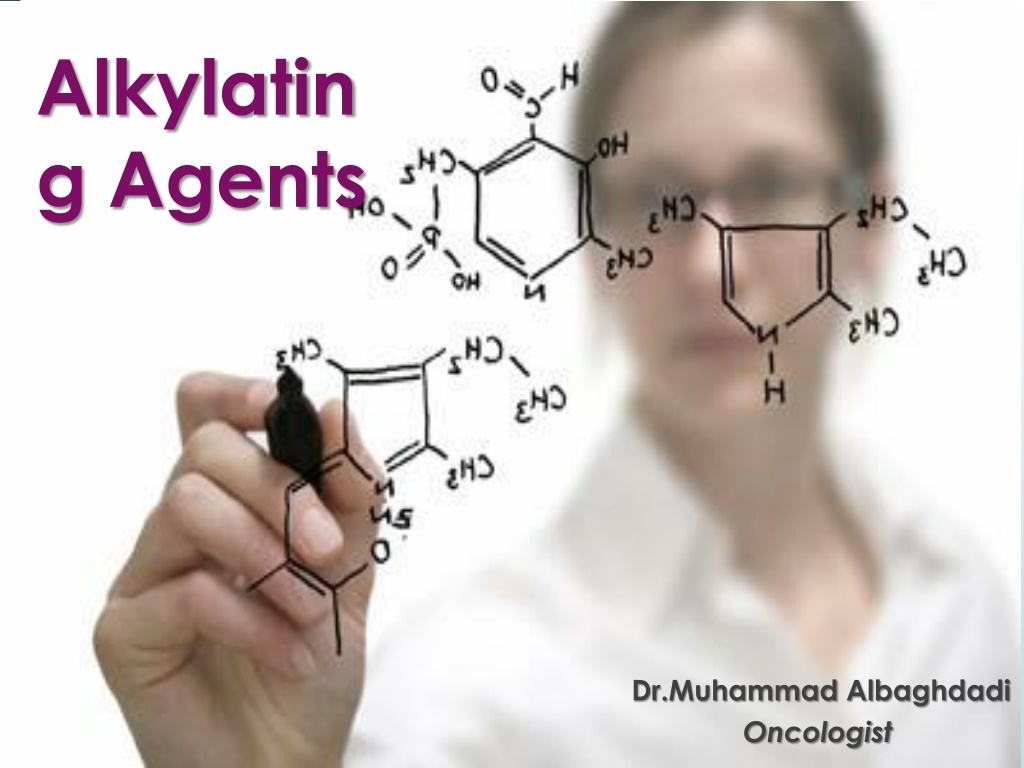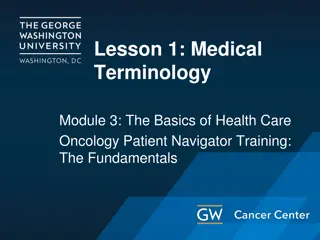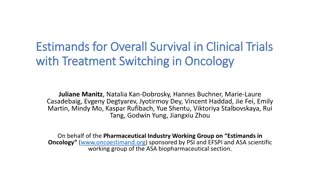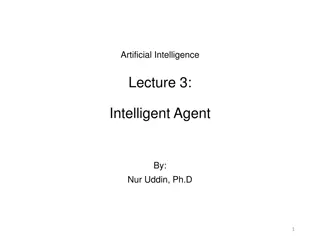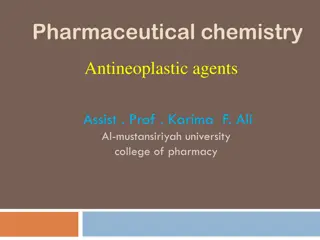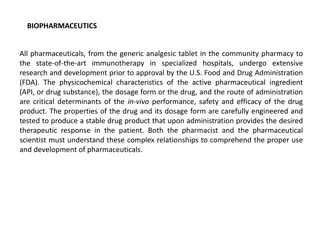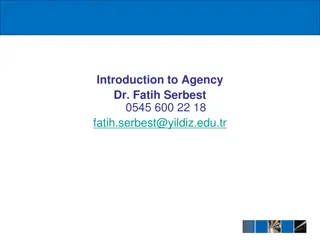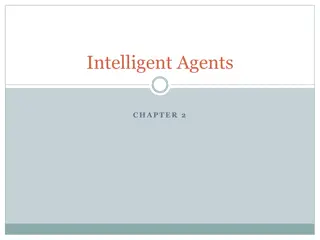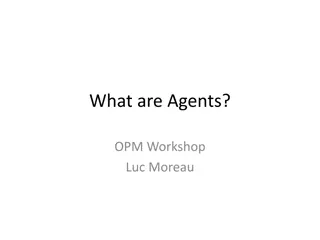Understanding Alkylating Agents in Oncology: Mechanisms and Pharmacokinetics
Alkylating agents have a long history as anti-cancer drugs, with Mechlorethamine being the first developed in 1942. They react with cells in all phases of the cell cycle, causing DNA alkylation and cross-link formation. Common alkylating agents include Cyclophosphamide, Melphalan, and Temozolomide. Their mechanism of action involves forming cytotoxic metabolites that damage DNA. In terms of pharmacokinetics, these agents have varied routes of administration, good tissue distribution, and are metabolized in the liver.
Download Presentation

Please find below an Image/Link to download the presentation.
The content on the website is provided AS IS for your information and personal use only. It may not be sold, licensed, or shared on other websites without obtaining consent from the author. Download presentation by click this link. If you encounter any issues during the download, it is possible that the publisher has removed the file from their server.
E N D
Presentation Transcript
Alkylatin g Agents Dr.Muhammad Albaghdadi Oncologist
HISTORY Mechlorethamine- first alkylating agent-1942 Analogue of Sulphur mustard gas Weapon in first world war-1917
Cont Alkylating agents were the first anticancer molecules developed, and they are still used today. After more than 50 years of use, the basic chemistry and pharmacology of this drug family is well understood and has not changed substantially.
Alkylating Agents Alkyl Sulfonate s Nitrogen Mustards Nitrosour eas Triazenes Aziridines Cyclophosp hamide Ifosfamide Melphalan Chlorambuc il Mechloretha mine Dacarbazi ne Temozolo mide Thio TEPA Carmustine Lomustine Streptozotocin Busulfan
alkylating agents react with cells in all phases of the cell cycle
Mechanism of DNA alkylation by a reactive nitrogen mustard molecule and formation of interstrand cross- link
Monofunctional adducts and 1,2- and 1,3- interstrand and intrastrand cross-links induced by DNA interactive agents. X = antitumour agent. M O A
Mechanism of Action M O A Inactive in parent form Activated by liver cyt- p450 to cytotoxic metabolites PM & acrolein DNA adduct
PHARMACOKINETICS ROA- iv in Dextrose 5% or NaCl 0.9 %, Oral Absorption bioavailability 90% Vol of Dist-0.6L/Kg Distribution-including brain & csf,also in milk & saliva Protein binding- <20% Cyclophosphamide & Ifosfamide
PHARMACOKINETICS Metabolism- Prodrug activation by Cyt-p450 active forms are 4 hydroxycyclophospham ide phosphoramide mustard & acrolein Elimination-t1/2- 4-6 hours parent drug & metabolites exclusively in urine Cyclophosphamide & Ifosfamide
Indications Breast Cancer Ovarian Cancer Sarcoma NHL High dose regimen-in bone marrow transplantation and for other autoimmune disorders
Dosage range Breast cancer 100mg/m2 po days 1-14 every 28 days,iv 600mg/m2 every 21 days AC or CMF NHL 400-600 mg/m2 iv every 21 days CVP,750mg/m2 every 21 days CHOP High dose BMT 60mg/kg iv for 2 days
Special consideration Caution in patients with abnl renal fuction Encourage fluid intake 2-3l/day Empty bladder several times daily
Toxicity Myelosuppression- dose limiting mainly leukopenia 7-14 days Nausea & vomiting 2-4 hrs Alopecia 2-3 wks Amenorrhoea with ovarian failure Cardiotoxicity Sec malig AML & bladder cancer SIADH
T O X I C I T Y Hemorrhagic cystitis- Excretion of Acrolein Rx Adequate hydration Continuous irrigation of bladder with MESNA (2mercaptoethanesulfonate) Frequent bladder emptying MESNA Free sulfhydryl Divided doses every 4 hrs- 60% of alkylating agents
PHARMACOKINETICS ROA- oral or iv Absorption- bioavailability 100% Distribution- Widely distributed Protein binding 20% Metabolism in liver Elimination- 50-70% excreted in urine T1/2- 3 -10hrs
Indication Osteogenic sarcoma Ewing sarcoma HL &NHL Non small cell & small cell lung cancer Bladder cancer Recurrent germ cell tumors
Special consideration Caution in patients with abnl renal function Uroprotection with mesna & hydration Monitor coagulation parameters
Toxicity Myelosuppression Bladder toxicity dose limiting Alopecia >80 % Amenorrhoea oligospermia
High dose ifosfamide Neurotoxicity T O X I C I T Y Seizures, altered mental status,CN palsies, coma Painful and acute exacerbation of peripheral sensory neuropathies and motor dysfunction of distal extremities Recommendations High risk - S.Cr>1.5mg or S.Albumin <3g/dl or both Multiple day regimens reduce risk N-linked Chloroethyl N-Deethylation Chloro Acetaldehyde Oxidation Monitor-early signs(irritability,anxiety,hallucinations) Terminate ifosfamide Palliative therapy
Indication HL NHL Cutaneous T cell lymphoma Intrapleural intrapericardial intraperitoneal treatment of metastatic disease
Melphalan Phenylalanine
CLINICAL USE Multiple Myeloma Ovarian cancer Myeloablative therapy Bone marrow transplant Melphalan
Chlorambucil Aromatic Mustard
Indication CLL NHL HL
Thiotepa Thiotepa
Indication Breast cancer Ovarian cancer HL NHL
Busulphan Busulphan
CLINICAL USE CML Myeloablative treatment- prior to BMT Busulphan
Carmustin (BiCNU) Nitrosourea
CLINICAL USE Brain tumour- GBM,glioma Multiple Myeloma Hodgkins Lymphoma,NHL Nitrosourea
Lomustin Nitrosourea
Indication Brain tumor HL NHL
Dacarbazine Nonclassic alkylating agent
Mechanism of Action Methylates nucleic acids and inhibits DNA RNA & protein syn
PHARMACOKINETICS ROA- iv Absorption- slow & variable Distribution- widely distributed Protein binding- 20% Metabolism- in liver Elimination- 40 -60% unchanged in urine t1/2- 5 hrs
Indication Metastatic malignant melanoma HL Sarcoma Neuroblastoma
Dosage range HL 375mg/m2 iv D1 D15 every 28 days ABVD
Special consideration Potent vesicant Use of aggressive antiemetics Avoid sunexposure
Toxicity Flu like syndrome CNS toxicity paresthesia neuropathies, ataxia,seizures Photosensitivity Teratogenic
Temozolomide Dacarbazine Spontaneously releases the cytotoxic species 3-methyl-(triazen-1-yl) imidazole-4- carboxamide(MTIC) Requires metabolic activation mediated by microsomal enzymes CH 3
Mechanism of Action Imidazotetrazine analog Methylates guanine residues(N7,O6) in DNA and inhibits DNA,RNA,protein syn Cytotoxicity-formation of O6 methyl guanine adducts
PHARMACOKINETICS ROA- Oral,iv Absorption- oral bioavailability 100% Food reduces Peak con- <1 h Nitrosourea
PHARMACOKINETICS CNS Penetration- High, CSF con 30-40% Selective distribution over tumour in brain Metabolism- MTIC &AIC Elimination- Majority in urine 40-50% t1/2- 1.8h Nitrosourea
Dosage range 150mg/m2 po daily for 5 days - 28 days 75mg/m2 po daily for 42 days with RT- GBM
CLINICAL USE Glioma Astrocytoma Melanoma Busulphan
